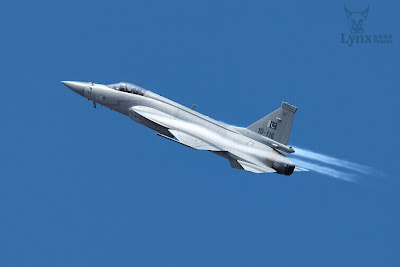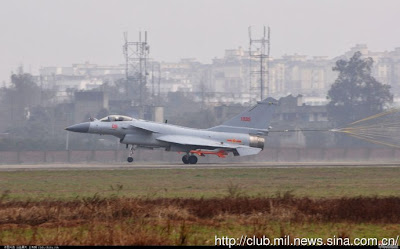 |
| Jf-17 Fighter Jet |
A half-dozen years ago, China's aircraft industry had not delivered a single competitive, operational fighter of its own design. Today, two are in service—the low-cost JF-17 and the J-10, the latter apparently comparable to most current in-production fighters—and China is still delivering bargain-basement fighters evolved from the classic Mikoyan MiG-21. The country's industry has developed an indigenous version of the Su-27 (the Russians might call it something less creditable) and is in the process of doing the same with the carrier-based member of the family, the Su-33.
Moreover, the Chengdu and Shenyang design teams have produced prototypes of two next-generation combat aircraft incorporating stealth technology, in the form of the canard-delta J-20 and the Lockheed Martin-influenced design identified as the J-31. An expanding range of air-launched missiles has been developed for the new fighters, together with new-generation sensors including active, electronically scanned array (AESA) radars and infrared search-and-track (IRST) systems.
China's flagship international fighter program is the JF-17 Thunder, developed and produced by Chengdu in cooperation with Pakistan, which has used it as a vehicle to create and grow its government-operated industry. It evolved from a series of Chinese studies of radically modified MiG-21s but was an entirely new aircraft by the time the design was unveiled at the Paris air show in 1999. In the same year, Pakistan signed the initial co-development agreement with China National Aero-Technology Import & Export Corp.(Catic).
“At the start of the project, Pakistan had no industrial or technological base,” Pakistan air force then-chief of staff Air Chief Marshal Rao Qamar Suleman said at a conference last year. However, he noted that Pakistan has participated in all stages of the design and helped develop the requirement for the fighter. The design was defined in 2001 and first flight took place in 2003, six prototypes were followed by a batch of eight Chinese-built aircraft for evaluation. Production in Pakistan started in 2005 and the first locally built aircraft rolled out in November 2009. According to Suleman, the type's performance “exceeded expectations,” leading to a decision to perform tests and introduce it into service in parallel.
Pakistan's goal is to replace its “vintage” fleet, comprising more than 250 Mirages and older Chinese F-7 and A-5III fighters, with JF-17s. The first batch of 42 aircraft, the last of them delivered earlier this year, replaced the A-5IIIs (a 1970s-era Chinese development of the MiG-19), equipping three squadrons. Overall, Suleman says, the JF-17 should allow the air force to replace its older fleet (not necessarily one-for-one, given the much greater capability of the new aircraft) at “one-third to one-fourth” the acquisition cost of any other modern fighter, with a similar savings in operating cost.
The JF-17 has been displayed at the Dubai and Farnborough air shows, and Pakistan's industry has talked to avionics suppliers worldwide about providing systems for the aircraft. According to the Russian media, the original contract for the fighter's RD-93 engine covered 100 powerplants with an option for 500 more, and an uprated 20,500-lb.-thrust version, the RD-93MA, is under development. Meanwhile, one JF-17 is reported to be flying in China with the Guizhou WS-13 engine.
Still under negotiation is the sale to Pakistan of the larger Chengdu J-10B, a modernized version of the canard-delta J-10. Although Pakistani interest in the J-10 has been reported since 2006, no firm deal has been announced. The most recent reports suggest that China has offered a squadron of J-10Bs. The new version differs from the original in featuring an AESA radar, IRST, a diverterless inlet and underwing fairings that point to an improved electronic-warfare suite.
Unlike the JF-17, neither the J-10 nor the J-10B has been demonstrated outside China. The J-10B's existence is known only via Internet leaks, but its existence makes the J-10 look like a sunset program. Also, the production of the J-10 still depends on Russian engine supplies.
China has ordered a total of 399 AL-31FN engines from Russia, according to Stockholm International Peace Research Institute data; its most recent order, for 123 engines, was placed last year. Of those, 276 had been delivered by 2011. Most of these power 220-plus J-10s, but others have been used in the Shenyang J-11B and J-15—the “bootleg” versions, respectively, of the Su-27 and Su-33. The indigenous WS-10A Taihang engine is under development and reported to be under test on J-10B and J-11B prototypes, but the 2011 order, covering four years of J-10 production at the rates seen so far, suggests that full production quantities of the WS-10A are not expected until 2015.
Technologically, the J-10B may be a stepping-stone to the J-20 and J-31. The status of China's stealth program has not become much clearer since the surprise appearance of the heavyweight J-20 at the end of 2010. However, the unveiling of the smaller—roughly Joint Strike Fighter-sized—J-31 points to the two designs being complementary, rather than alternatives. Despite their different shapes and sizes, the J-20 and J-31 are similar in that they appear to have advanced beyond the stage of being pure technology demonstrators. Both are larger than the J-10, pointing to a future three-level force mix.
In the next few years, the pace of Chinese fighter development may be set by the resources available and the sheer number of programs. In 2005, China had three major fighter projects underway: the JF-17, J-10 and J-11B. Today, it has the J-10B and J-15, and both Chengdu and Shenyang have challenging stealth programs.
Courtesy: www.aviationweek.com





No comments:
Post a Comment